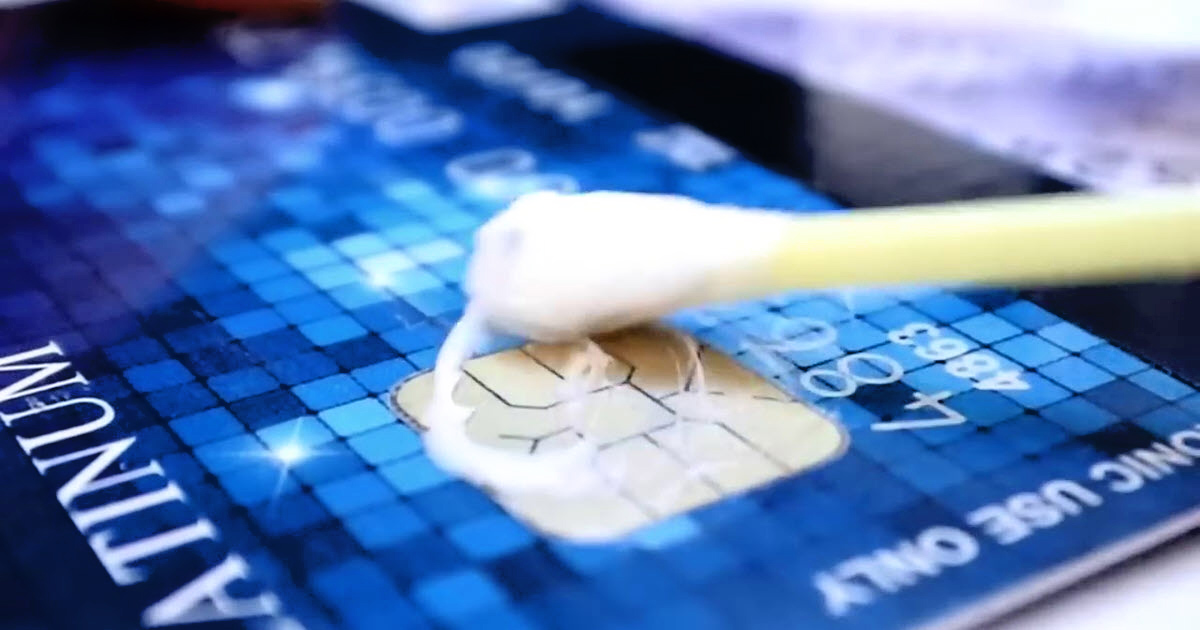

Finance
How To Destroy An EMV Chip
Published: March 6, 2024
Learn how to disable an EMV chip and protect your finances with our expert guide. Take control of your financial security today.
(Many of the links in this article redirect to a specific reviewed product. Your purchase of these products through affiliate links helps to generate commission for LiveWell, at no extra cost. Learn more)
Table of Contents
**
Introduction
**
In today's digital age, the EMV chip has become a ubiquitous feature of credit and debit cards, revolutionizing the way transactions are conducted and enhancing security measures. The EMV chip, also known as the Europay, Mastercard, and Visa chip, is a small, metallic square embedded in payment cards. This chip is designed to authenticate card transactions, significantly reducing the risk of fraud compared to traditional magnetic stripe cards. While the EMV chip offers enhanced security, there are instances where individuals may consider destroying it due to various reasons. This article delves into the intricacies of EMV chips, the potential consequences of tampering with them, and the methods associated with their destruction.
Understanding the significance of EMV chips and the potential ramifications of tampering with them is crucial for individuals seeking to make informed decisions regarding their financial assets. As such, this article aims to provide a comprehensive overview of EMV chips and the implications of their destruction, shedding light on the legal and ethical considerations surrounding this contentious topic. By examining the risks and consequences associated with destroying an EMV chip, individuals can gain a deeper understanding of the potential repercussions of such actions. Furthermore, this article will explore the various methods used to destroy EMV chips, offering insights into the technical aspects of this process.
As we embark on this exploration, it is important to approach the subject matter with a discerning eye, recognizing the complexities and implications associated with tampering with EMV chips. By delving into this multifaceted topic, readers will be equipped with the knowledge necessary to navigate the intricate landscape of financial security and ethical considerations. Let us embark on this enlightening journey to unravel the nuances of EMV chips and the potential ramifications of their destruction.
Understanding EMV Chips
EMV chips represent a significant advancement in the realm of payment card technology, offering robust security features that aim to thwart fraudulent activities. Unlike traditional magnetic stripe cards, which store static data that can be easily replicated, EMV chips generate dynamic data for each transaction, making it exceedingly difficult for fraudsters to clone cards or conduct unauthorized transactions. This dynamic authentication process, known as EMV technology, has been instrumental in reducing the incidence of counterfeit card fraud in many parts of the world.
At the core of an EMV chip lies a microprocessor that is capable of performing cryptographic functions and securely storing sensitive information. This microprocessor is instrumental in facilitating secure transactions by generating unique cryptograms for each payment, rendering stolen transaction data virtually useless for unauthorized purposes. Furthermore, EMV chips are designed to support various cardholder verification methods, such as PIN entry and signature verification, adding an extra layer of security to card transactions.
EMV technology has gained widespread adoption due to its effectiveness in combating card-present fraud, where a criminal attempts to use a counterfeit or stolen card to make a purchase. The implementation of EMV chips has significantly reduced the susceptibility of payment cards to skimming devices and counterfeit card schemes, bolstering consumer confidence in the security of electronic payments.
It is important to note that EMV chips are not impervious to all forms of fraud, and they primarily address card-present transactions. As such, they do not offer comprehensive protection in online or card-not-present transactions, where alternative security measures such as tokenization and 3D Secure protocols are utilized to mitigate fraud risks. Nevertheless, the deployment of EMV chips has marked a pivotal advancement in securing in-person card transactions, underscoring the ongoing evolution of payment card technology in safeguarding consumers against financial malfeasance.
Risks and Consequences of Destroying an EMV Chip
Deliberately destroying an EMV chip entails a myriad of risks and potential repercussions, ranging from legal and financial implications to practical inconveniences. The primary consequence of tampering with an EMV chip is the compromise of the card’s security features, leaving it vulnerable to unauthorized use and fraudulent activities. By disabling the EMV chip, individuals inadvertently expose themselves to heightened risks of card cloning, unauthorized transactions, and potential liability for fraudulent charges.
Furthermore, destroying an EMV chip may lead to the deactivation of the payment card by the issuing financial institution. As EMV chips are integral to the card’s security and functionality, their deliberate destruction may be viewed as a violation of the cardholder agreement, prompting the issuer to deactivate the compromised card to prevent potential misuse. This can result in significant inconvenience for the cardholder, necessitating the issuance of a replacement card and the reconfiguration of any recurring payment arrangements linked to the original card.
From a legal standpoint, tampering with an EMV chip may contravene the terms and conditions outlined by the card issuer, potentially leading to legal repercussions and financial liabilities. In the event of fraudulent transactions stemming from the compromised card, the cardholder may encounter challenges in disputing the charges and proving that the unauthorized activities were not facilitated by their actions. This could result in financial losses and damage to the individual’s creditworthiness, impacting their ability to secure future lines of credit or loans.
Moreover, the deliberate destruction of an EMV chip raises ethical considerations, particularly in the context of responsible financial behavior and adherence to contractual agreements. Cardholders are entrusted with the responsibility of safeguarding their payment cards and utilizing them in accordance with the terms established by the issuing financial institution. By intentionally disabling the EMV chip, individuals deviate from the expected standards of card usage, potentially undermining the integrity of the financial system and eroding trust within the payment card ecosystem.
It is imperative for individuals to recognize the gravity of the risks and consequences associated with destroying an EMV chip, as the ramifications extend beyond individual actions to encompass broader implications for financial security, regulatory compliance, and ethical conduct.
Methods to Destroy an EMV Chip
Destroying an EMV chip is a delicate and intricate process, as the chip is designed to withstand physical tampering and maintain its integrity under normal usage conditions. While the intentional destruction of an EMV chip is discouraged due to the associated risks and legal implications, it is essential to understand the methods that may be employed for this purpose.
One method of destroying an EMV chip involves subjecting it to extreme heat, such as using a blowtorch or exposing it to an open flame. The intense heat can cause the chip to melt or become damaged, rendering it inoperable. However, this approach requires precision and caution, as excessive heat can pose safety hazards and damage the surrounding card material. Additionally, the use of open flames or high-temperature sources necessitates adherence to safety protocols and legal considerations.
Another method entails physically puncturing or drilling into the EMV chip, thereby compromising its internal structure and functionality. This approach requires specialized tools and expertise to ensure that the chip is effectively incapacitated without causing damage to the rest of the card. It is crucial to exercise caution when employing this method, as excessive force or improper techniques may result in unintended damage to the card or render it unusable for legitimate transactions.
Chemical methods may also be considered for destroying an EMV chip, involving the use of corrosive substances or solvents to degrade the chip’s components. However, the application of chemicals raises environmental and safety concerns, necessitating careful handling and disposal practices to mitigate potential risks and adhere to regulatory requirements.
It is important to emphasize that the destruction of an EMV chip is a complex and nuanced undertaking, and individuals contemplating such actions should be mindful of the legal and ethical implications associated with tampering with payment card technology. The deliberate destruction of an EMV chip should not be undertaken lightly, and individuals are encouraged to explore alternative courses of action when addressing concerns related to their payment cards.
Legal and Ethical Considerations
When contemplating the destruction of an EMV chip, it is essential to navigate the complex landscape of legal and ethical considerations that underpin such actions. From a legal perspective, tampering with the EMV chip of a payment card may contravene the terms and conditions outlined by the card issuer, potentially leading to legal repercussions and financial liabilities. Cardholder agreements typically stipulate the expected standards of card usage and may explicitly prohibit any attempts to modify or disable the card’s security features. Engaging in activities that violate these terms could result in the cardholder being held accountable for any ensuing financial losses or fraudulent transactions.
Furthermore, the intentional destruction of an EMV chip may run afoul of statutory regulations and consumer protection laws governing payment card usage. Regulatory authorities and financial oversight bodies often impose stringent requirements to safeguard the integrity of payment systems and protect consumers from financial malfeasance. By disregarding these regulations and engaging in unauthorized modifications to payment cards, individuals may find themselves entangled in legal disputes and regulatory scrutiny.
From an ethical standpoint, the deliberate destruction of an EMV chip raises concerns regarding responsible financial behavior and adherence to contractual agreements. Cardholders are entrusted with the responsibility of safeguarding their payment cards and utilizing them in a manner consistent with the principles of integrity and trust. By intentionally disabling the EMV chip, individuals may undermine the fundamental tenets of ethical conduct within the financial ecosystem, potentially eroding the trust and reliability of payment card systems.
It is imperative for individuals to recognize the gravity of the legal and ethical considerations associated with the destruction of an EMV chip. Engaging in such activities not only exposes individuals to legal and financial risks but also undermines the collective efforts to maintain the security and stability of payment card systems. As such, individuals are encouraged to explore alternative avenues for addressing their concerns related to payment cards, such as requesting a card replacement, seeking guidance from the card issuer, or exploring additional security measures to protect their financial assets.
Conclusion
As we conclude our exploration of the intricacies surrounding the EMV chip and its potential destruction, it is evident that this subject matter encompasses a multifaceted array of considerations, ranging from technical intricacies to legal and ethical implications. The EMV chip represents a pivotal advancement in payment card security, leveraging dynamic authentication mechanisms to thwart fraudulent activities and enhance consumer protection. Its widespread adoption has significantly bolstered the security of in-person card transactions, underscoring the ongoing evolution of payment card technology.
Deliberately destroying an EMV chip carries substantial risks and consequences, encompassing legal liabilities, financial repercussions, and ethical considerations. Tampering with the security features of a payment card not only violates the terms and conditions set forth by the card issuer but also undermines the collective efforts to maintain the integrity and trustworthiness of payment card systems. Individuals contemplating such actions are urged to exercise prudence and consider the broader implications of their decisions, recognizing that the deliberate destruction of an EMV chip may have far-reaching effects on financial security and regulatory compliance.
It is imperative for individuals to approach concerns related to their payment cards through legitimate channels and in adherence to the established protocols. Seeking guidance from the card issuer, exploring alternative security measures, or requesting a card replacement are viable avenues for addressing apprehensions without resorting to the destruction of the EMV chip. By engaging in responsible financial behavior and upholding the ethical standards governing payment card usage, individuals can contribute to the collective efforts aimed at preserving the integrity and trustworthiness of payment card systems.
As we navigate the dynamic landscape of financial technology, it is essential to remain cognizant of the evolving security measures and the ethical responsibilities that accompany the use of payment cards. By fostering a culture of conscientious financial conduct and embracing the principles of integrity and trust, individuals can play a pivotal role in upholding the resilience and reliability of payment card systems, ensuring the continued protection and security of financial transactions for all stakeholders.














